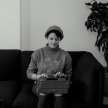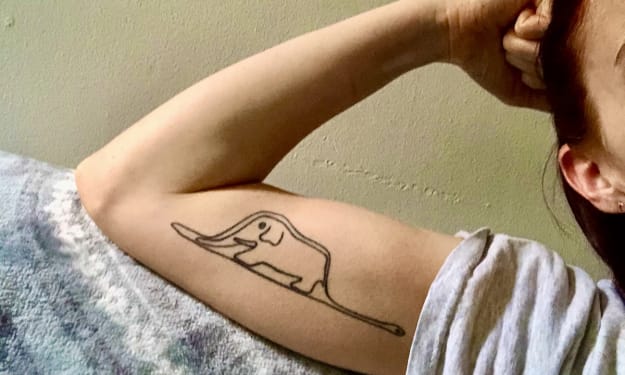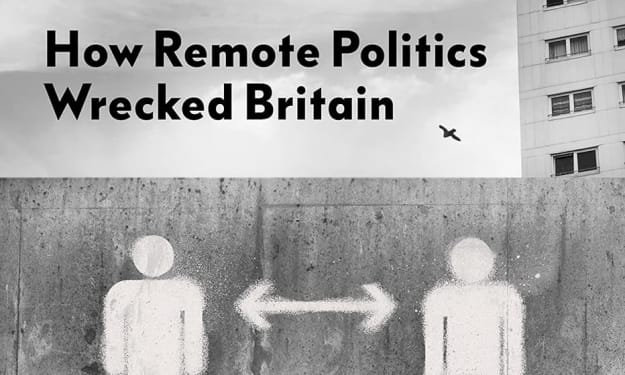IRL
What's real? What's not? Who defines reality?

Inspired by John Green’s podcast ‘The Anthropocene Reviewed’ where he rates different aspects of our human-centered geological age on a 5-star scale, I decided to do the same for quarantine. You can read all my quarantine reviews and sign up to get them in your inbox here.
-----------------------------------------------------------------------------------------
When I first returned to Brooklyn after quarantining with my parents for 4 months, I spent a good 48 hours cleaning and reorganizing my apartment. Since I won’t be working from an office for the foreseeable future and there’s still no reason to leave home other than to buy groceries, I wanted to make my apartment look like a place where, as a co-worker mentioned on a Zoom call, I could “write the next great American novel.”
I also managed to acquire a lot of stuff during lockdown that I needed to make room for. Stuff I really don’t need, like a globe and a candelabra, but nevertheless purchased.
I’ve tried to achieve the delicate balance of having my apartment look lived in but also ready to be photographed for a lifestyle magazine. The attention to detail I’ve given to redecorating kind of reminds me of the trashy Victorian novel Lady Audley’s Secret that I read in college. Not because I relate to the criminal heroine, but because of the many passages that describe her rooms as settings designed for her to star in.
Every evidence of womanly refinement was visible in the elegant chamber. My lady’s piano was open, covered with scattered sheets of music and exquisitely-bound collections of scenas and fantasias which no master need have disdained to study. My lady’s easel stood near the window, bearing witness too my lady’s artistic talent, in the shape of a water-coloured sketch of the Court and gardens. My lady’s fairy-like embroideries of lace and muslin, rainbow-hued silks, and delicately-tinted wools littered the luxurious apartment; while the looking-glasses, cunningly placed at angles and opposite corners by an artistic upholsterer, multiplied my lady’s image, and in that image reflected the most beautiful object in the enchanted chamber.
All the world was Lady Audley’s stage—she had absolute power over her surroundings. The whole point of emphasizing her beauty and the way she arranged her home, of course, was to show that appearances can be deceiving. Anyone who focuses too much on appearances, perhaps, has much to hide.
I think about this every now and then when I’m sitting in the reading chair I’ve carefully angled in a corner of my apartment so that I can see out the window whenever I happen to lift my gaze from one of the books (that are artfully stacked) I’ve picked up from a little side table. I’m not a cruel villain like Lady Audley, but the attention I give to the placement of each item in my apartment does suggest that I’m trying to hide something about myself. It’s not that I don’t think my home is a reflection of who I am—it is—but it’s also scenery, part of a great performance.
Performances are meant for an audience. When people watch a ballet or symphony orchestra, they’re seeing the final, polished product. What they don’t see are the hours of grueling practice, the skipped meals, the sacrifices that go into that performance. We may acknowledge the hard work of the performer in passing, but it happens offstage. It’s what happens onstage that matters in the end.
*********
Working from home during this pandemic has made meetings with co-workers personal. All our interactions happen via Zoom calls, and unless someone keeps their camera off or uses a background, Zoom allows the people you know in a professional capacity a glimpse into your home life.
During meetings, I usually position myself so that people can see the mantle of my non-working fireplace and other decor behind me. I suppose the goal is to get a compliment, like this one I received a few days ago: “Your home is very modern Sherlock Holmes.” A well-received performance.
What I choose to show people on Zoom isn’t reality. It’s scenery. It’s a wall I’ve put up to conceal reality. Well, abstract more than conceal. My Zoom background is one small piece of the puzzle people would need to put together in order to see my life in full. But they don’t have access to all the pieces, so they just have to take what I choose to show them at face value, and I’m OK with that.
*********
Even the sliver of life we choose to show people—on Zoom, social media, or elsewhere—is out of our control. The platforms we use to curate the parts of our lives we want to show people can’t always hide the realities we don’t want them to see.
I read a news story back in August about a young student in a Florida elementary school whose mother was shot and killed while the student was in the middle of an online lesson over Zoom. The teacher apparently muted herself to prevent the class from witnessing the reality of this student’s domestic life. The teacher later told police that she saw the face of the child reacting to the arguing, the struggle, the gunshot (hands on ears), before that one little box in her Zoom grid went black.
I haven’t followed up on the details of this story since I first read it. So much was still developing at that time. I would assume that the mother was killed by a partner, by someone she knew.
Now that many of us are forced to interact with people online in ways that don’t just generate likes, comments, clicks, love, our online lives are bound to seem a lot more real.
*********
If you’re a millennial or younger, you’ve probably used IRL in a sentence at least once in your life. The acronym stands for ‘in real life,’ which may have originally been used to distinguish reality from things that happen in video games, on social media, or on TV, but now has a more nuanced meaning.
Usually I hear people use IRL in a tongue-in-cheek way to distinguish their normal, everyday lives from the ones they lead online. Put simply, the phrase that’s now represented by a texting shorthand highlights that there’s a staged quality to our online existence, which can take the form of filtered Instagram photos (it’s funny that people will sometimes use the #unfiltered to indicate that they didn’t touch up or alter the reality of a photo in any way), opinionated Facebook posts, or witty tweets.
This isn’t to say that there aren’t ways to be authentic on the internet, and who’s to say that any of us are more authentic in our normal lives? Take online dating, for example—ideally everyone on a dating app would be honest about who they are in their profile, because online matches need to move offline eventually (unless, of course, we’re never allowed to interact with other humans again). Profile pics and the back-and-forth messages can only stand in for the physicality of a person for so long.
While it’s excepted that what we choose to show online is typically a stylized version of ourselves, IRL feels like a cop out, a reason to excuse certain online behavior. If we’re all in agreement that the online world isn’t real, then there can be no consequences for our actions in that space.
It’s easy to forget, I think, that the people you interact with online are real people with real emotions. For that very reason, I don’t believe there is a distinction between the life you lead online and off—it’s just your life. And as this pandemic persists, the line we’ve drawn between what’s IRL and not will become indistinguishable.
Back in 2017, Mozilla launched the podcast IRL to address the fact that many of us don’t treat online life as real life, despite being able to “walk, talk, work, LOL, and even love on the internet.” From trolling to data security to free speech, the podcast makes the case that what happens in our online lives does have an offline impact. A hacker can steal your identity. Your social media profiles can keep you from getting your dream job. A flood of cruel comments from people you don’t even know can take a toll on your mental health.
We’re all still fragile, vulnerable humans on the internet.
*********
The different ways real can be used in a sentence might help us settle on a definition:
- They look so real. You might use this sentence to convey that you’re impressed with how much some wax roses in a hotel lobby look like actual roses.
- Shit just got real. You might use this sentence if something intense just happened, particularly an argument where someone has thrown a stinging insult.
- This dinner is really good. You might use this sentence if the dinner you’re eating is not just good but exceptional. Only it’s not exceptional enough to call it anything other than really good.
But do any of these uses help explain what makes something real? Or is reality subjective?
When I was a kid, there seemed to be a real world that all the adults in my life inhabited, but that I wasn’t a part of yet. This was a world where bills needed to be paid, where you were often made to do things you didn’t want to do. “Enjoy being young while you can, for the real world is looming” is a sentiment I was at least made to feel growing up if those precise words weren’t uttered to me. But what part of my childhood wasn’t lived in the real world? What about my experience wasn’t real?
When I was a teenager and longing for something more than high school, the concept of a real world seemed like an escape hatch. It was something other than what I was living. This mindset also absolved me from taking responsibility for my own life, for my own misery. But there was no real world I was suddenly going to enter once I graduated. Everything I have lived and experienced is real, and everything I will live and experience is real.
*********
When we use IRL or the real world, we’re dismissing experiences that we think fall outside the neat box labeled reality. But what counts as reality is usually decided at the expense of people of color, women, the LGBTQ+ community, people with disabilities, the list goes on. If your experience falls outside the purview of what’s considered mainstream (white, male, cisgender), it’s too difficult to understand.
This is why the Black Lives Matter movement, why any legitimate movement, needs to exist—if white, able-bodied people don’t see something, then it isn’t real. And despite the growing power of BLM, despite video evidence of police murdering black people, there is still pushback, there is still disbelief. There are white supremacists who have their own alternate reality they want to enforce. There are white men in power who can’t have BLM toppling the reality they need to persist—one where they hold all the power and continue to get richer.
At the first Vice Presidential debate between Mike Pence and Kamala Harris, Pence offered his sympathies over the murder of Breonna Taylor, but in the same breath said that we need to trust that justice had been served in her case. This is the warped reality that the Trump Administration and Republicans want their supporters to believe: Black people can die at the hands of the police, but police officers aren’t at fault. They can’t let truth ruin the reality they want to live in.
That was another dangerous thing Pence did during the debate: He tried to frame the facts Harris was presenting as liberal opinions. Three times he told Harris, “You’re entitled to your own opinion, not your own facts,” a quote attributed to a former Democratic senator from New York, Daniel Patrick Moynihan. Oddly enough, it was Pence who captured—in his stupid misuse of this quote—why we live in a post-truth society, why so many of us think the facts are open for interpretation: Opinion has overwhelmingly come to stand in for fact.
*********
Growing up, I never believed that my teddy bear was a living, breathing being. He was a round shape with stubs for arms and legs, not life-like at all. I never use it when referring to my stuffed bear, though; always he. Probably because my emotional connection to one Ted E. Bear was real, even if the bear wasn’t.
In Sherry Turkle’s 2006 essay “Tamagotchi Love,” she argues that because my teddy bear wasn’t animated or life-like in any way that I was able to grow the capacity for developing a relationship outside of the one I had with my mother, while still maintaining space between my self and the toy. Transitional objects are what the English pediatrician and psychoanalyst Donald Winnicott called teddy bears and rag dolls. They’re “mediators between the child’s earliest bonds with its mother, whom the infant experiences as inseparable form the self, and the child’s growing capacity to develop relationships with other people who will be experienced as separate beings,” Turkle says.
Turkle goes on to explain that we’ve moved away from giving children transitional objects to play with and instead offer them life-like relational artefacts as companions. The difference between my childhood teddy bear, say, and a Tamagotchi (a popular toy I also owned at one point in my childhood) is that Ted never asked me for a hug or anything else he might have needed. I just imagined when my bear could use a hug. But my Tamagotchi pet would demand what it needed from me—food, water, constant attention—and if I didn’t provide these things it would die.
I usually hugged my teddy bear whenever I needed a hug, but I would project that sadness or hurt onto my stuffed companion so that I would feel a little less alone. Without realizing it, I was learning to cope with my emotions, to soothe myself with the help of a transitional object. Can a Tamagotchi that apparently has its own needs allow a child to process their emotions in the same way?
Sure, a Tamagotchi is nothing like a real pet, but it does replicate the way a child might relate to one. All the machines we use today are designed to replicate some aspect of a real relationship. That’s what makes them so addictive. Turkle observes that “in the move from traditional transitional objects to contemporary relational artefacts, projection gives way to engagement.” Working in the digital marketing space, engagement is a key, if not overused, term in a marketer’s vocabulary. Marketers equate engagement with customers liking their brand. In the marketing world, an email open or Facebook like need to be stand-ins for real love.
But we have so many stand-ins for reality that it almost seems like we get a choice of what is real, what is truth. Turkle begins her essay with an exchange she had with her 14-year-old daughter and her friends while waiting in line to see a Darwin exhibit at the American Museum of Natural History. Turkle’s daughter and the other young millennials in line agreed that the real (the actual) turtles used in the exhibit weren’t needed, for the museum could have just used robots instead. The reason the teenagers gave was that it would be “less gross,” and a robot turtle can be programmed to be more animated than a living turtle.
The attitude of these teenagers is interesting: Why bother using a real turtle when you can use a clean, antiseptic robot? Something created in a turtle’s image sans the smell and gross mess. Sans the reality of the living creature.
The other thing about a robot is that we can, presumably, control it, though many a sci-fi novel shows that this logic is bound to blow up in our faces. According to the teenagers in Turkle’s essay, the museum apparently had a choice: to show people real turtles, or to show them robots so life-like that they’re almost more impressive than real turtles.
*********
When it comes to what’s real, what’s true, there is no choice to be made. If you’re being an awful troll online, then you’re an awful troll offline, too. An awful troll is who you are. The problem is that we compartmentalize our lives, rarely stepping back to look at ourselves fully.
It is easier to cherry pick or invent the truths we want to believe rather than confront the messiness of reality. Perhaps for some old, white men, the toppling of Confederate statues and slave owners is difficult to stomach because they were once believed to be heroes. And many people in this country—the current president included—don’t want to accept that the United States of America was built on the backs of slaves, on land stolen from native peoples who white settlers exterminated. But that is reality.
The acronym IRL lets us off the hook. It allows us to be revisionists when it comes to telling the story of who we are and how we behave. I give IRL 1 star.

About the Creator
Maggie Blaha
Maggie is a placeless writer who is wandering around Europe in search of a home—a place where she can live simply, write often, and read always. She's currently living in Spain.






Comments
There are no comments for this story
Be the first to respond and start the conversation.